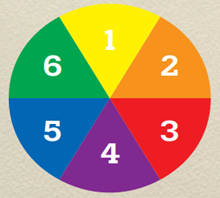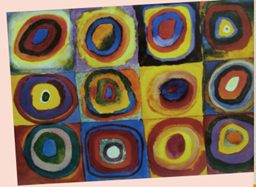Tiếng Anh 8 CLIL Art: Colours1. Check the meaning of the words in the box. Do you know any other adjectives to describe colours? 2. Read the text. Write the names of colours 1–6 on the colour wheel. Which colours are primary and which are secondary? 3. Read and listen to the text again. Complete the sentences using the words in exercise 1. Tổng hợp đề thi học kì 2 lớp 8 tất cả các môn - Chân trời sáng tạo Toán - Văn - Anh - Khoa học tự nhiên
Lựa chọn câu để xem lời giải nhanh hơn
Bài 1 I can name colours and say how they relate to each other (Tôi có thể gọi tên các màu và nói chúng liên quan với nhau như thế nào) 1. Check the meaning of the words in the box. Do you know any other adjectives to describe colours? (Kiểm tra nghĩa của các từ trong hộp. Bạn có biết bất kỳ tính từ nào khác để mô tả màu sắc?)
Lời giải chi tiết: - complementary: (màu) đối lập, bổ túc - harmonious: hài hòa - pastel: (màu) phấn - primary: (màu) cơ bản - secondary: (màu) thứ cấp - vibrant: tươi sáng Other adjectives to describe colours: light, dark, bright, dull, vivid, cold, bleak, faded, neutral, brilliant. (Các tính từ khác để mô tả màu sắc: sáng, tối, tươi sáng, mờ, sống động, lạnh, ảm đạm, mờ nhạt, trung tính, rực rỡ.) Bài 2 2. Read the text. Write the names of colours 1–6 on the colour wheel. Which colours are primary and which are secondary? (Đọc văn bản. Viết tên của các màu từ 1–6 trên bánh xe màu. Màu nào là cơ bản và màu nào là thứ cấp?) Ex: 1. yellow – primary The Colour Wheel
Have you ever thought about how colours are related? Why do some colour combinations look good and others don’t ? According to Isaac Newton, white light consists of all the colours of the rainbow. Newton then arranged them in a circle of warm and cool categories. Red, blue and yellow are the three primary colours on the colour wheel. By mixing two primary colours, we’ve got the secondary colours green, orange and purple. Colours can also be harmonious or complementary. Complementary colours are directly opposite each other, like red and green. Harmonious colours sit next to each other on the wheel. Famous artists and decorators have used the colour wheel to choose the right colours ever since then. Everyone agrees that colours can affect our feelings. A vibrant red, for example, is often associated with anger or danger, while yellow is a happy colour. Blue can make people feel calm; pastel pink, which is a gentle pink, sometimes makes them think of romance, and green is the colour of nature. What’s your favourite colour? What do you associate it with? (Bánh xe màu sắc Bạn đã bao giờ nghĩ về màu sắc có liên quan như thế nào chưa? Tại sao một số kết hợp màu trông đẹp còn những màu khác thì không? Theo Isaac Newton, ánh sáng trắng bao gồm tất cả các màu của cầu vồng. Newton sau đó sắp xếp chúng thành một vòng gồm các loại nóng và lạnh. Đỏ, xanh lam và vàng là ba màu cơ bản trên bánh xe màu. Bằng cách trộn hai màu cơ bản, chúng ta có các màu thứ cấp là xanh lục, cam và tím. Màu sắc cũng có thể hài hòa hoặc bổ sung cho nhau. Các màu bổ sung đối lập trực tiếp với nhau, chẳng hạn như màu đỏ và màu xanh lá cây. Màu sắc hài hòa nằm cạnh nhau trên bánh xe. Kể từ đó, các nghệ sĩ và nhà trang trí nổi tiếng đã sử dụng bánh xe màu để chọn màu phù hợp. Mọi người đều đồng ý rằng màu sắc có thể ảnh hưởng đến cảm xúc của chúng ta. Ví dụ, màu đỏ rực rỡ thường liên quan đến sự tức giận hoặc nguy hiểm, trong khi màu vàng là màu hạnh phúc. Màu xanh có thể làm cho mọi người cảm thấy bình tĩnh; hồng pastel là một màu hồng nhẹ nhàng đôi khi khiến các nàng liên tưởng đến sự lãng mạn, còn xanh lá cây là màu của thiên nhiên. Bạn thích màu nào? Bạn liên kết nó với cái gì?) Lời giải chi tiết: The names of colours 1–6 on the colour wheel: (Tên của các màu từ 1–6 trên bánh xe màu:) 1. yellow - primary colour (màu vàng - màu cơ bản) 2. orange - secondary colour (cam - màu thứ cấp) 3. red - primary colour (đỏ - màu cơ bản) 4. purple - secondary colour (tím - màu thứ cấp) 5. blue - primary colour (xanh lam - màu cơ bản) 6. green- secondary colour (xanh dương - màu thứ cấp) Bài 3 3. Read and listen to the text again. Complete the sentences using the words in exercise 1. (Đọc và nghe lại văn bản. Hoàn thành các câu sử dụng các từ trong bài tập 1.) 1. Yellow and purple are _______ colours. 2. Blue and red are _______ colours. 3. A _______ colour is bright and strong. 4. Green and yellow are _______ colours. 5. Orange and purple are _______ colours. 6. A _______ colour is pale and soft. Lời giải chi tiết:
1. Yellow and purple are complementary colours. (Màu vàng và màu tím là màu bổ sung.) 2. Blue and red are primary colours. (Màu xanh và đỏ là màu cơ bản.) 3. A vibrant colour is bright and strong. (Một màu rực rỡ thì tươi sáng và mạnh mẽ.) 4. Green and yellow are harmonious colours. (Màu xanh lá cây và màu vàng là những màu hài hòa.) 5. Orange and purple are secondary colours. (Cam và tím là màu thứ cấp.) 6. A pastel colour is pale and soft. (Một màu pastel thì nhạt và nhẹ nhàng.) Bài 4 4. USE IT! Work in groups. Look at Wassily Kandinsky’s painting Squares with Concentric Circles. Choose two squares in the painting and say how the colours in each square are related. Which square do you like best and why? (Làm việc nhóm. Nhìn vào bức tranh Squares with Concentric Circles của Wassily Kandinsky. Chọn hai hình vuông trong bức tranh và cho biết màu sắc trong mỗi hình vuông có liên quan với nhau như thế nào. Bạn thích hình vuông nào nhất và tại sao?)
A: … and … are harmonious / complementary colours. (… và … là những màu hài hòa/bổ sung cho nhau.) B: I like … because it looks … . It reminds me of … (Tôi thích… bởi vì nó trông…. Nó làm tôi nhớ đến / liên tưởng đến / nghĩ đến …) Lời giải chi tiết: A: (Square 3) Red and yellow are harmonious colours. Red and blue are complementary colours. I like square 5 because it looks impressive. It reminds me of eyes. ((Hình vuông 3) Màu đỏ và màu vàng là những màu hài hòa. Màu đỏ và màu xanh là màu bổ sung. Tôi thích hình vuông 5 vì nó trông ấn tượng. Nó làm tôi nghĩ đến đôi mắt.) B: (Square 9) Blue and green are harmonious colours. Green and red are complementary colours. I like square 9 because it looks like harmony and peace. It reminds me of images of the earth or a forest around the lake. ((Hình vuông 9) Xanh lam và xanh lục là những màu hài hòa. Màu xanh lá cây và màu đỏ là màu bổ sung. Tôi thích hình vuông 9 vì nó có vẻ hài hòa và yên bình. Nó làm tôi liên tưởng đến hình ảnh của trái đất hoặc một khu rừng quanh hồ.)
|

















